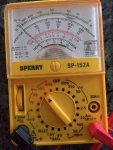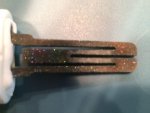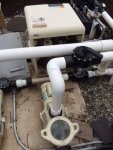I tried to fire up my Pentair Mastertemp 400 heater yesterday, but I couldn't get ignition. Start sequence:
1. Blower comes on 2. Here a click 3. Smell gas. This repeats three times and then the "service heater" light comes on. I thought that perhaps there was air in the gas line. So I did this several times....waiting 5 minutes between. No luck.
So I try to troubleshoot. I read the manual. I pull the panels. to gain access to look at the LEDs on the board and the flashing light on the ignition module. I turn on the heater...and it starts!!! So I stop the heater, replace the panels, set the valves to heat my spillover spa, and started the heater.
I figured it was air in the gas lines. The heater ran for about 30 minutes. I figured 30 minutes of operation would have surely purged any air in the gas line.
When it reached temperature, the heater shut off. It didn't, however, come back on.
After getting dried off, I tried to start the heater and had the same results (blower, click, smell gas). So I pulled the panels and attempted to start again....thinking maybe there is an air flow problem. No luck.
No LEDs lit up. The control panel light flashed three times. This indicates an "Ignition Lockout" condition.
So i disconnected the wires to the igniter and test with a multimeter. Note: I'm not extremely comfortable with the multimeter...but I think I'm competent enough to check resistance. Anyway, I think I successfully tested and got a reading of 95 ohms.
While researching, I found this very slow and boring video:
https://www.youtube.com/watch?v=J_efWFDlQVg
It states that on some igniters the range is 50-90 ohms. 50 is good and at 90 they need replaced.
I then found some instructions from Pentair:
http://www.pentairpool.com/pdfs/MasterTemp.MaxEThermHeaterIgnitor.pdf
It states that anything from 50-500 ohms is OK. From what I've been able to gather online, this seems like a very large range for an igniter.
Help!!!
Am I on the right track?
At what level of resistance should I replace the igniter?
1. Blower comes on 2. Here a click 3. Smell gas. This repeats three times and then the "service heater" light comes on. I thought that perhaps there was air in the gas line. So I did this several times....waiting 5 minutes between. No luck.
So I try to troubleshoot. I read the manual. I pull the panels. to gain access to look at the LEDs on the board and the flashing light on the ignition module. I turn on the heater...and it starts!!! So I stop the heater, replace the panels, set the valves to heat my spillover spa, and started the heater.
I figured it was air in the gas lines. The heater ran for about 30 minutes. I figured 30 minutes of operation would have surely purged any air in the gas line.
When it reached temperature, the heater shut off. It didn't, however, come back on.
After getting dried off, I tried to start the heater and had the same results (blower, click, smell gas). So I pulled the panels and attempted to start again....thinking maybe there is an air flow problem. No luck.
No LEDs lit up. The control panel light flashed three times. This indicates an "Ignition Lockout" condition.
So i disconnected the wires to the igniter and test with a multimeter. Note: I'm not extremely comfortable with the multimeter...but I think I'm competent enough to check resistance. Anyway, I think I successfully tested and got a reading of 95 ohms.
While researching, I found this very slow and boring video:
https://www.youtube.com/watch?v=J_efWFDlQVg
It states that on some igniters the range is 50-90 ohms. 50 is good and at 90 they need replaced.
I then found some instructions from Pentair:
http://www.pentairpool.com/pdfs/MasterTemp.MaxEThermHeaterIgnitor.pdf
It states that anything from 50-500 ohms is OK. From what I've been able to gather online, this seems like a very large range for an igniter.
Help!!!
Am I on the right track?
At what level of resistance should I replace the igniter?





